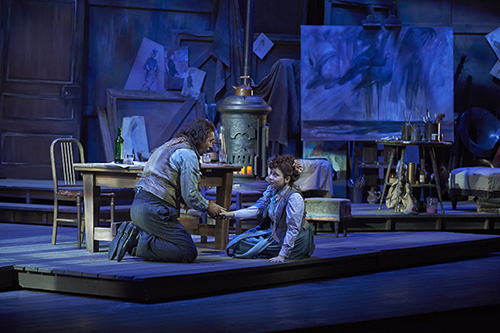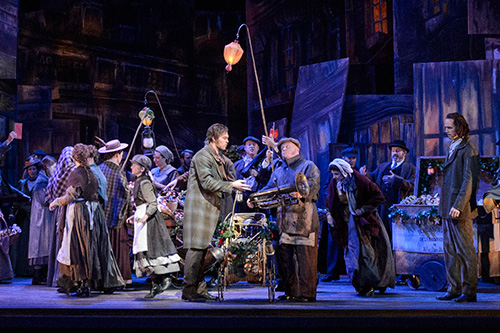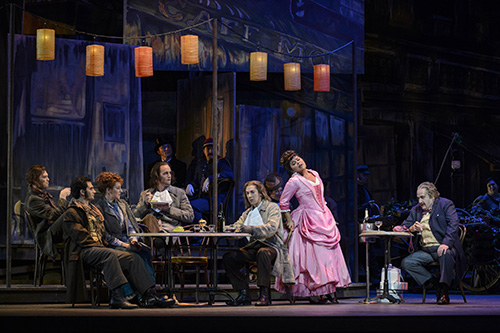-
Canvases Come Alive: Set and Costume Designer David Farley Discusses La Bohème
By Danielle D'OrnellasPosted in La BohèmeBy Suzanne Vanstone

Beloved Bohème. No matter how many times one experiences this iconic work, the extraordinary pull of Puccini’s music continues to draw us in. With 15 COC mainstage productions and numerous mini-Bohèmes on tour and in recital, outdoors and in, the company is once again proud to present this cherished opera in a brand new production.
 Set and costume designer David Farley visited the COC this past summer to explore the theatre space firsthand. “I had only seen the Four Seasons Centre for the Performing Arts in drawings or photos so it was great to be able to walk the room and get an idea of sightlines, the quirks of the building, and things to watch out for as we approach load-in.” He also met with various staff in the COC’s production department to discuss sets, costumes, props, wigs and make-up. He wanted to give them insight into how the production works, potentially tricky things to watch out for and, above all, to get everyone excited and invested in the project.
Set and costume designer David Farley visited the COC this past summer to explore the theatre space firsthand. “I had only seen the Four Seasons Centre for the Performing Arts in drawings or photos so it was great to be able to walk the room and get an idea of sightlines, the quirks of the building, and things to watch out for as we approach load-in.” He also met with various staff in the COC’s production department to discuss sets, costumes, props, wigs and make-up. He wanted to give them insight into how the production works, potentially tricky things to watch out for and, above all, to get everyone excited and invested in the project.La Bohème is often staged in the 1850s which is when Henri Murger’s literary work Scènes de la vie de bohème was written. But after some initial conversations, director John Caird and Farley agreed that while they still wanted a period piece, they preferred the 1890s – when the actual opera was written. “It is a prettier era costume-wise with much nicer silhouettes, and there was a much more vibrant arts scene in Paris at that time.” As Farley further researched artists living and working in Paris, he wanted to find the “real-life Marcellos” and quickly came to the conclusion that famed painter Toulouse-Lautrec fit the bill. “Toulouse-Lautrec was the one who was hanging around street corners sketching every last detail of real life – he has a wonderful energy to his work and would literally paint on any surface. There are acres of sketches and studies that he did – not very detailed, but they have a wonderful movement and life to them. They reflect the feel of the music in the opera which is so lush and vibrant.”
It is a natural fit for Marcello to represent the Parisian artists who frequent the cafés and sketch life as it swirls around them. Caird and Farley also posited that perhaps Marcello had been recording the lives of his capricious group of friends in his notebook. And perhaps we, the audience, are looking back and seeing this story through his eyes. Farley says, “We go from the garret, the artist’s studio, where we see Marcello’s sketches and canvases lying around, to the café and the street world that could then literally be created through the canvases that he has painted. With a few flown-in pieces the canvases form a collage, a vista of a street.” Art imitating life… imitating art.

In terms of the costumes, Farley said it was tricky finding references to everyday people and not just the fashion prints of the very high class as recorded in portraits. He wanted to know what people truly wore. In the course of his research he stumbled across work by photographer Eugène Atget from the early 1900s. Atget, obsessed by the changes that were happening in Paris through industrialization, wanted to record everything, taking hundreds of photos of the bread sellers, the sweet makers, the urchin kids on the street corner, the shop fronts – beautiful, detailed images of people in everyday wear. Using these photographs as his guide, Farley was able to create costumes of great diversity. Members of the chorus have their own individual looks and tell their own individual stories.
La Bohème is a co-production with Houston Grand Opera and San Francisco Opera, and was first mounted in October 2012 in Houston. Having the chance to remount a production is a gift for a designer. “We always knew it was coming to Toronto and to this specific theatre, so we were able to keep that in mind in terms of sightlines and size of stage, etc. But it is wonderful to be able to revisit a show. No matter how well designed a piece is, there is always something that, once you see it on stage, you wish you had done a little bit differently – but there is just not time nor finances to go back and tweak it at that stage. We have so much of this Bohème working beautifully and we know that it has a good solid base, but to finesse those last few things and make them really right – it’s great.

“The Four Seasons Centre itself is a beautiful space and it’s a real treat to go into a purpose-built, new building. To see a modern performing space that has been designed so well and with such integrity is wonderful. The attention to detail is quite impressive and I am really looking forward to our show ‘sitting’ here and spending more time in this building.
“Bohème is one of those pieces that is so well loved and enjoyed; it just ticks all the boxes. Falling in love, out of love, camaraderie, foolery, slapstick – Puccini runs the gamut and crams a little bit of everything in. You really can’t go wrong!”
Photos from the Canadian Opera Company production of La Bohème, 2013: (top) Dimitri Pittas as Rodolfo and Grazia Doronzio as Mimì. Photo by Michael Cooper; (middle) David Farley; (front, wearing green coat) Cameron McPhail as Schaunard and (front right, wearing grey suit) Tom Corbeil as Colline. Photo: Chris Hutcheson; (bottom) Photo by Chris Hutcheson.
